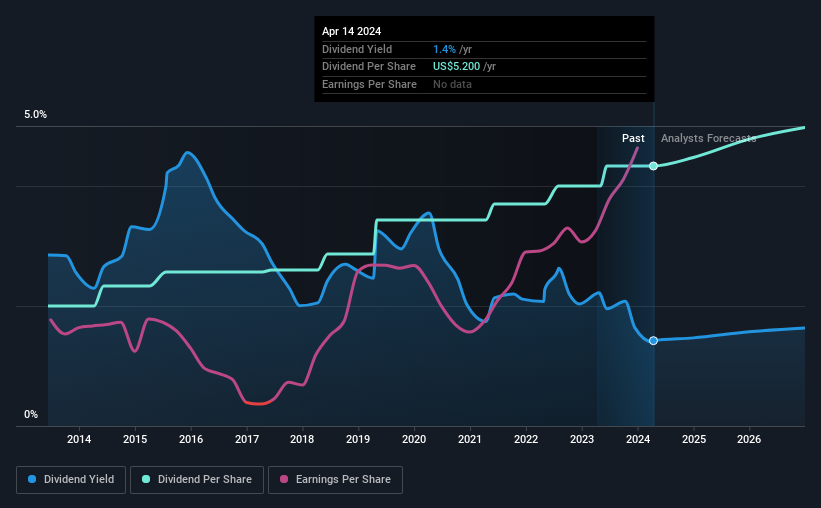Caterpillar Inc. (NYSE:CAT) Looks Interesting, And It's About To Pay A Dividend
Some investors rely on dividends for growing their wealth, and if you're one of those dividend sleuths, you might be intrigued to know that Caterpillar Inc. (NYSE:CAT) is about to go ex-dividend in just four days. The ex-dividend date is one business day before a company's record date, which is the date on which the company determines which shareholders are entitled to receive a dividend. The ex-dividend date is important as the process of settlement involves two full business days. So if you miss that date, you would not show up on the company's books on the record date. Thus, you can purchase Caterpillar's shares before the 19th of April in order to receive the dividend, which the company will pay on the 20th of May.
The company's next dividend payment will be US$1.30 per share, on the back of last year when the company paid a total of US$5.20 to shareholders. Last year's total dividend payments show that Caterpillar has a trailing yield of 1.4% on the current share price of US$365.63. We love seeing companies pay a dividend, but it's also important to be sure that laying the golden eggs isn't going to kill our golden goose! So we need to investigate whether Caterpillar can afford its dividend, and if the dividend could grow.
Check out our latest analysis for Caterpillar
Dividends are usually paid out of company profits, so if a company pays out more than it earned then its dividend is usually at greater risk of being cut. That's why it's good to see Caterpillar paying out a modest 25% of its earnings. Yet cash flow is typically more important than profit for assessing dividend sustainability, so we should always check if the company generated enough cash to afford its dividend. Thankfully its dividend payments took up just 26% of the free cash flow it generated, which is a comfortable payout ratio.
It's positive to see that Caterpillar's dividend is covered by both profits and cash flow, since this is generally a sign that the dividend is sustainable, and a lower payout ratio usually suggests a greater margin of safety before the dividend gets cut.
Click here to see the company's payout ratio, plus analyst estimates of its future dividends.
Have Earnings And Dividends Been Growing?
Companies with consistently growing earnings per share generally make the best dividend stocks, as they usually find it easier to grow dividends per share. Investors love dividends, so if earnings fall and the dividend is reduced, expect a stock to be sold off heavily at the same time. Fortunately for readers, Caterpillar's earnings per share have been growing at 15% a year for the past five years. Earnings per share have been growing rapidly and the company is retaining a majority of its earnings within the business. This will make it easier to fund future growth efforts and we think this is an attractive combination - plus the dividend can always be increased later.
Another key way to measure a company's dividend prospects is by measuring its historical rate of dividend growth. Caterpillar has delivered an average of 8.0% per year annual increase in its dividend, based on the past 10 years of dividend payments. It's encouraging to see the company lifting dividends while earnings are growing, suggesting at least some corporate interest in rewarding shareholders.
To Sum It Up
Has Caterpillar got what it takes to maintain its dividend payments? Caterpillar has been growing earnings at a rapid rate, and has a conservatively low payout ratio, implying that it is reinvesting heavily in its business; a sterling combination. There's a lot to like about Caterpillar, and we would prioritise taking a closer look at it.
While it's tempting to invest in Caterpillar for the dividends alone, you should always be mindful of the risks involved. In terms of investment risks, we've identified 2 warning signs with Caterpillar and understanding them should be part of your investment process.
A common investing mistake is buying the first interesting stock you see. Here you can find a full list of high-yield dividend stocks.
Have feedback on this article? Concerned about the content? Get in touch with us directly. Alternatively, email editorial-team (at) simplywallst.com.
This article by Simply Wall St is general in nature. We provide commentary based on historical data and analyst forecasts only using an unbiased methodology and our articles are not intended to be financial advice. It does not constitute a recommendation to buy or sell any stock, and does not take account of your objectives, or your financial situation. We aim to bring you long-term focused analysis driven by fundamental data. Note that our analysis may not factor in the latest price-sensitive company announcements or qualitative material. Simply Wall St has no position in any stocks mentioned.

